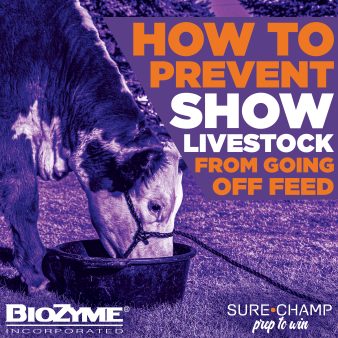
Summertime means show time for many lamb and goat exhibitors. However, keeping your lambs and goats fresh, feeling and looking their best can be challenging, especially during the hottest parts of the year. With some persistence and consistency to your schedule, you can ease the challenges and keep your small ruminants feeling great and show ready all summer long.
Lori Lawrence, Hebron, Ohio, and Cooper Bounds, Good Hope, Illinois, have years of experience preparing show lambs and goats for the show ring. Lawrence’s daughter showed lambs competitively, during which time the preparation became a family project, like many do. Bounds was an early Boer goat exhibitor from Maryland and today raises high-quality show goats and coaches livestock judging at Western Illinois University.
In a day where both the lamb and goat rings are becoming increasingly competitive, it is important to keep your livestock on track as you #preptowin.
Keeping it Simple
Bounds said that some basic animal husbandry is key to keeping goats on feed and water. Make sure they have good air flow and ventilation, clean bedding and clean fresh water. As goats are temperature-sensitive, it makes sense to keep them in an area where they have clean airflow and good fans or even the use of a port-a-cool, but make sure they don’t get too cold when it gets cooler in the evenings and overnight.
Clean bedding is also essential. Take time to clean the bedding multiple times a day to keep the dampness out of it. Bounds said the bedding type doesn’t matter as much as the cleanliness of it.
Both he and Lawrence agree that goats and lambs will drink, eat and feel better if they are supplied with fresh water multiple times a day.
“Keep an eye on your water situation. Fresh, clean, cold water is really crucial to digestive health and keeping them eating,” Lawrence said.
If Bounds has animals that are not drinking or eating, he adds Vita Charge® Liquid Boost to the water. Liquid Boost is a supplement for all species that contains Amaferm® and MOS to support the ability to recover from the effects of stress. Amaferm®️ is a prebiotic designed to enhance digestibility by amplifying the nutrient supply for maximum performance. It is research-proven to increase intake, digestion and absorption. MOS traps bad bacteria limiting their ability to do harm. Liquid Boost also includes organic Zinc, the antioxidant Vitamin E and B vitamins. Amaferm is research-proven to combat stress by supporting the animal’s own immune system, significantly increasing intake and nutrient utilization.
Nutrition 101
While water is essential, Lawrence said it is also imperative to make sure the feed is fresh to ensure the livestock will eat it. She recommends keeping feed in airtight containers like feed buckets with lids, trash cans with lids or simply keeping the bags rolled up between feedings.
She also keeps their lambs on a consistent feed schedule, feeding them the same time, twice a day, within a 30-minute window, so if they are fed at 5 p.m., tonight, they are not fed any later than 5:30 tomorrow night. Every lamb is given an individual ration, and feed pans are pulled after a specific amount of time, usually when the lambs start slowing down.
Bounds said if he has a goat struggling to eat, he has found competition offers encouragement to get back on feed. He will introduce the competition either by hanging feeders face-to-face on the fence or pairing up two goats to eat together, which encourages the slower eater to become more aggressive.
Just as good feed is important, hay is also important to ruminants to keep their digestive system in check. Bounds said high-quality hay that is not too rich is what he prefers to offer the goats in his barn. Lawrence cuts back to a small handful of hay, about softball size, after she grains the lambs, once they are older to keep their digestive system working.
Both Lawrence and Bounds use Vita Charge® Climate Control Gel to help regulate their animals’ temperatures, which also helps keep them eating and drinking. The Vita Charge Climate Control Gel contains Capsaicin to help maintain circulation to support animal performance in heat stress situations. Capsaicin is research-proven to support animals’ ability to maintain normal body temperature, keeping the animal more comfortable. Climate Control Gel also contains Amaferm.
“Goats are very temperature sensitive so as we get into the spring and summer with warm days and cooler nights and trying to keep the temperature more at bay and not get as much stress from it, keeping their internal temperature right is important to keep them rolling. Climate Control Gel is a tool that can be used in the summer to prevent heat stress. I do like the Vita Charge® products and follow the recommended dosage. Get them on the Vita Charge Liquid Boost and Climate Control to help keep them cool and keep them eating and drinking,” Bounds said.
Exercise Matters
As with any animal that is kept in a small pen most of its life, making sure it has adequate exercise is important. Lawrence emphasized that every lamb is different, and just as they require different feed rations, they also likely need different exercise programs, but not until they reach heavier weights. And that same could be said for the difference between lambs and goats. Bounds said although he encourages getting goats out of the pens each day for practice walking and setting up, he doesn’t promote real intense exercise until the goats are more mature and starting to get some fat cover on them.
For Lawrence, their lamb exercise program is a mix of intense running or tracking alternated with a day off, then a day of tracking backward, then a day of practice setting up and showing. Sundays are a “free day” when the lambs get to run in an empty lot and just be lambs.
“We turn then in an open lot with no grass to run, play and relax. This gives them a chance to just be sheep while also working all their muscles. It also allows us to evaluate them on the loose. Somedays they look their best out there,” Lawrence said.
Hair and Hide
While keeping them healthy on the inside can be the big challenge, making sure they look their best also takes time and effort too. And there are some vast differences in taking care of your lambs and goats according to our two sources.
For lambs, Lawrence said the major focus is keeping leg wool or hair clean, growing and looking show-ready. Of course, keeping the rest of the lamb clean is important, and that is why once the lamb has been washed once, she likes to keep a canvas blanket on the lamb to help keep its natural oils in it. When it comes to preserving the leg wool, she says she rinses it from the “hide out” meaning she penetrates the water all the way to the hide to get to the wool roots and doesn’t just let the water set on top of the wool. This also allows her to take time to look through the wool to make sure there is no dirt or dander. This is also the same way she rubs in conditioning cream.
Bounds said that he will blanket a goat for about two weeks after it’s been sheared to help protect the goat from any fungus or insects. After that time, he removes the blanket and focuses on hair growth and cleanliness. Goats are bathed two to three times a week, and after each time they are washed, treated with a conditioner like clean sheen. Summertime is an exciting time for goat and lamb exhibitors. Don’t let the added heat and stress that accompanies it, dampen your excitement or fun. Follow these tips from knowledgeable experts when it comes time to taking care of lambs and goats and make your efforts to #preptowin seem more exciting too.

